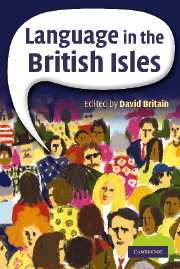Book contents
- Frontmatter
- Contents
- List of figures
- List of tables
- List of contributors
- Acknowledgements
- Map of the British Isles
- Introduction
- Part I English
- 1 The history of English
- 2 Standard and non-standard English
- 3 Phonological variation in England
- 4 Grammatical variation in England
- 5 Scottish English and Scots
- 6 Northern Irish English
- 7 Southern Irish English
- 8 English in Wales
- 9 English on the Isle of Man
- 10 English in the Channel Islands
- Part II The Celtic Languages
- Part III The Other Languages of the British Isles
- Part IV Applied Sociolinguistic Issues
- References
- Index
4 - Grammatical variation in England
Published online by Cambridge University Press: 16 January 2010
- Frontmatter
- Contents
- List of figures
- List of tables
- List of contributors
- Acknowledgements
- Map of the British Isles
- Introduction
- Part I English
- 1 The history of English
- 2 Standard and non-standard English
- 3 Phonological variation in England
- 4 Grammatical variation in England
- 5 Scottish English and Scots
- 6 Northern Irish English
- 7 Southern Irish English
- 8 English in Wales
- 9 English on the Isle of Man
- 10 English in the Channel Islands
- Part II The Celtic Languages
- Part III The Other Languages of the British Isles
- Part IV Applied Sociolinguistic Issues
- References
- Index
Summary
Introduction
There have been rather fewer studies of grammatical as opposed to phonological variation in the English of England, and fewer have provided quantitative analyses to highlight relative distributions of grammatical forms (and the social and linguistic factors which affect them) across the country. This situation has perhaps been due to the fact that larger corpora are usually needed to analyse grammatical phenomena statistically because of their less frequent occurrence in spoken language than the segmental phonological features that have tended to dominate the literature on sound variation. The collection of larger corpora has facilitated studies of grammatical variation, however, and we are now fortunate to have, for some non-standard features at least, a number of systematic analyses of an appropriate empirical depth to begin to piece together a more sensitive picture of variation in England.
Our knowledge, though, is still patchy. This chapter reviews the literature on grammatical variation in the non-standard dialects of England since the mid-1980s, when Language in the British Isles was first published, and, as the review shows, some of the detail about non-standard features still comes from relatively informal observation, with little known about regional distribution, nor about just how robustly some of the features are still used. One example of this is the reflexive pronoun system. Many non-standard dialects of England have a regularised paradigm, adding the reflexive suffix -self to the relevant possessive pronoun, hence: myself, yourself, hisself, herself, ourselves, theirselves.
- Type
- Chapter
- Information
- Language in the British Isles , pp. 75 - 104Publisher: Cambridge University PressPrint publication year: 2007
- 15
- Cited by

